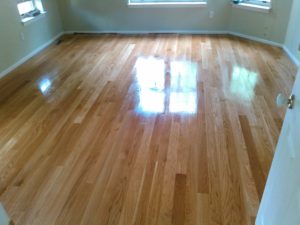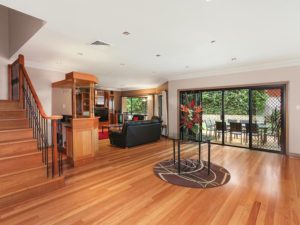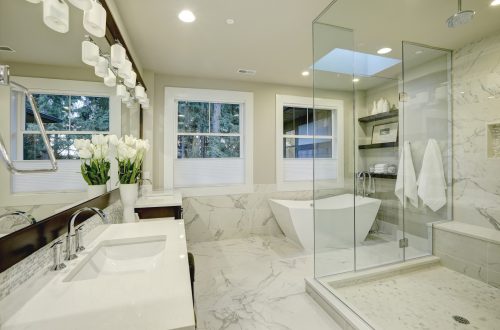Solid v.s. Engineered Wood Floors – What’s right for your home
Wood is a timeless and classic choice for flooring in any home. It adds warmth, stability, value to your home, and let’s not forget that cozy feeling too. If installed and maintained properly, a solid wood floor has the potential to last a lifetime. But how do you know what type of wood floor is the right choice for your home? With all the factory advances there’s a lot to choose from, and different components to think about. We all want a beautiful looking floor, but the main goal with a wood floor, is to make sure you choose the material that will last the longest, and has the durability your particular home and family needs.
So here’s an overview of both solid and Engineered wood floors.
Both Engineered and Solid Hardwoods are made with 100% real wood, the difference between them, is in their construction.
What’s the difference?
Solid hardwood floors are exactly what they sound like; solid pieces of wood, milled from a single piece of lumber, into plank flooring.
Engineered wood flooring is constructed in layers. Depending on the manufacturer, it has a core of either solid wood layers or plywood layers, and has a final layer of solid wood attached to the top, known as its “wear layer.”

Thickness –
Solid Hardwood Flooring – The normal thickness of solid hardwood is 3/4 inch, allowing for multiple refinishing throughout it’s life, and solid structural stability.
Engineered wood floors- Manufactured in different thicknesses with the number of layers ranging anywhere from 3 to 12, all glued together. There are also options in the thickness of the top wear layer being between 1mm to 5mm thick, ultimately offering you more or less refinishing options over the life of the floor.
Where it can be installed in your home –
Solid Hardwood Flooring- Because solid hardwood is temperamental in moist and damp environments with unstable temperature and humidity levels, it’s recommended to be installed either on grade (first floors of your home) or above grade (any additional floors of your home ex. 2nd and/or 3rd floors). It’s never recommended to install solid hardwood in below grade levels, such as a basement.
Engineered Wood Floors- Due to it’s construction, Engineered wood flooring can be installed on any grade of your home, including your basement. While every wood floor expands and contracts, because Engineered floors are constructed in layers, it has less movement and is more resilient to the temperature and humidity fluctuation than solid hardwood. Most Engineered wood floors can be installed over both wood and cement subfloors, making it a nice choice of flooring if you’re looking to maintain a level of material consistency throughout your home.

Performance –
Solid Hardwood Flooring- Solid hardwood flooring is 100% genuine wood. Each wood species has its own natural character traits and durability levels, so it’s not easy to make a general statement about the performance of wood, overall…. But to keep it simple, what you need to know is that a solid wood floor, no matter the species, is capable of adding value to your home, and when maintained, will last much longer than an Engineered wood floor. Depending on the specific needs of your home and environment, certain wood species are recommended over others for durability. For example, we wouldn’t recommend installing a Pine floor in a high traffic area like a kitchen or in a busy household with pets and children, simply because it’s more susceptible to scratches and dents than other more dense woods. You can learn more about different wood species and their characteristics and densities HERE.
Engineered Wood Floors – Most Engineered Wood floors are constructed to offer slightly more resilience in regard to moisture than solid hardwood. Their cores are generally stacked layers of wood in a cross-grain configuration, which lessens the amount of expanding and contracting. This doesn’t mean it can handle sitting water- Remember, it’s still genuine wood and needs to be maintained as such, but as opposed to Solid hardwood floors, most Engineered floors can be installed over a cement slab and below grade, under the right conditions.
How long does it last –
Solid Hardwood Flooring- When installed in the proper environment, and that environment is maintained, a Solid Hardwood floor has the potential to last your entire lifetime. There are various finishing options to suite the particular needs of your home, and they can be sanded and refinished many times, as opposed to Engineered flooring where they can only be sanded once. If you choose a pre-finished solid hardwood floor, the top aluminum oxide coating will prove to be added scratch and wear resistance, eliminating the need to refinish your floors for many years, with normal use and maintenance.
Engineered Wood Floors- Because Engineered wood floors can’t be sanded and refinished multiple times, they don’t generally last as long as a Solid Hardwood floor does in any home with normal wear and tear. However, Engineered wood floors come with a more durable finish than a solid, site-finished hardwood floor. The extra scratch resistant and durable factory finish applied to Engineered wood floors is similar to the aluminum oxide finish applied to pre-finished solid hardwood floors.
Refinishing –
Engineered Wood Floors- Typically, an Engineered Wood floor can only be sanded and refinished once, maybe twice in it’s lifetime, depending on the materials specific wear layer.
Solid Hardwood Flooring- Because Solid hardwood flooring is thicker than Engineered floors, they can be sanded and refinished many times over. Having a flooring material that can be aesthetically changed to suite your own style and color preference is a great asset, especially if you’re deciding on selling your home at some point. Seeing solid hardwood floors in a home is incredibly appealing to home-buyers because they already know that they can refinish whats existing and make it their own. When there’s Engineered flooring, home-buyers have very few options to change the appearance of their floors, other than replacing them altogether.
Installation –
Engineered Wood Floors- How to install an Engineered Wood Floor really depends on the manufacturer recommendations for the particular material. The thinner Engineered floors are generally glued down, there are also click and locking floating engineered floor systems, and lastly, much thicker Engineered floors that can be stapled and nailed down to a wood subfloor for installation.
Solid Hardwood Floors- Solid hardwood floors are installed by securing them to a wood subfloor using staples, cleats or nails. As a general rule, any solid wood floor with a width over 4 inches, is installed using subfloor adhesive in addition to the staples, cleats and nails. Properly installing solid hardwood flooring is not something we recommend DIY’ers to attempt. A good, solid installation is really important in ensuring the floors structural integrity, and that the floors last, so leaving it to professionals is always recommended.
Appearance-
We all know that solid hardwood flooring can be site finished to your own personal preference, making it the most customizable flooring choice there is. Engineered wood floors have come a long way since they were first manufactured back in the 60’s. There are a lot of new, highly evolved top layer veneers out today that include many of the custom looks that are achieved with solid floors. You can, without a doubt, find an Engineered wood floor with the look and style you want, but remember, once you settle on a style, you’re pretty much stuck with it for the life of the floor (with the exception of refinishing once). With a solid hardwood floor, you can change the appearance as many times as you like, until there’s no more floor to sand down.
Cost
Solid hardwood is more expensive to purchase and install vs and engineered hardwood floor. However, if you think about this as a long term expense, solid hardwood is cheaper. Short term, engineered hardwood is a cheaper alternative to solid, however, long term it ends up being more expensive. I know it may not make sense but think of it this way- solid hardwood is usually a once in a lifetime buy. Meaning that once it’s installed, you wont need to install it again in the same area. Sanding and refinishing it is a course of maintenance that will ensure the longevity of the floor. Hardwood has the option of repairs and weave ins if damaged as opposed to engineered hardwoods. If an engineered hardwood is damaged, chances are you will not be able to find the exact floor for a repair and you will need to replace the entire floor.
If you have a material you’re considering, we offer Free consultations and estimates for your convenience.


36 Comments
Pingback:
Pingback:
Pingback:
Pingback:
Pingback:
Pingback:
Pingback:
Pingback:
Pingback:
Pingback:
Pingback:
Pingback:
Pingback:
Pingback:
Pingback:
Pingback:
Pingback:
Pingback:
Pingback:
Pingback:
Pingback:
Pingback:
Pingback:
Pingback:
Pingback:
Pingback:
Pingback:
Pingback:
Pingback:
Pingback:
Pingback:
Pingback:
Pingback:
Pingback:
Pingback:
Pingback: